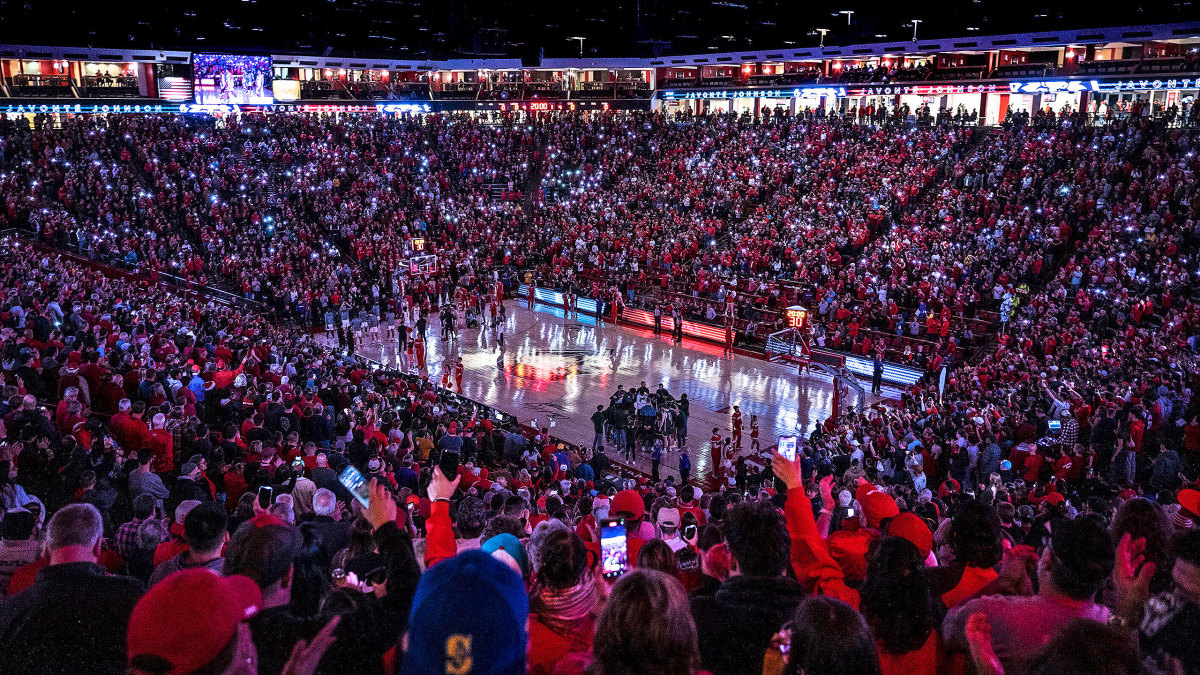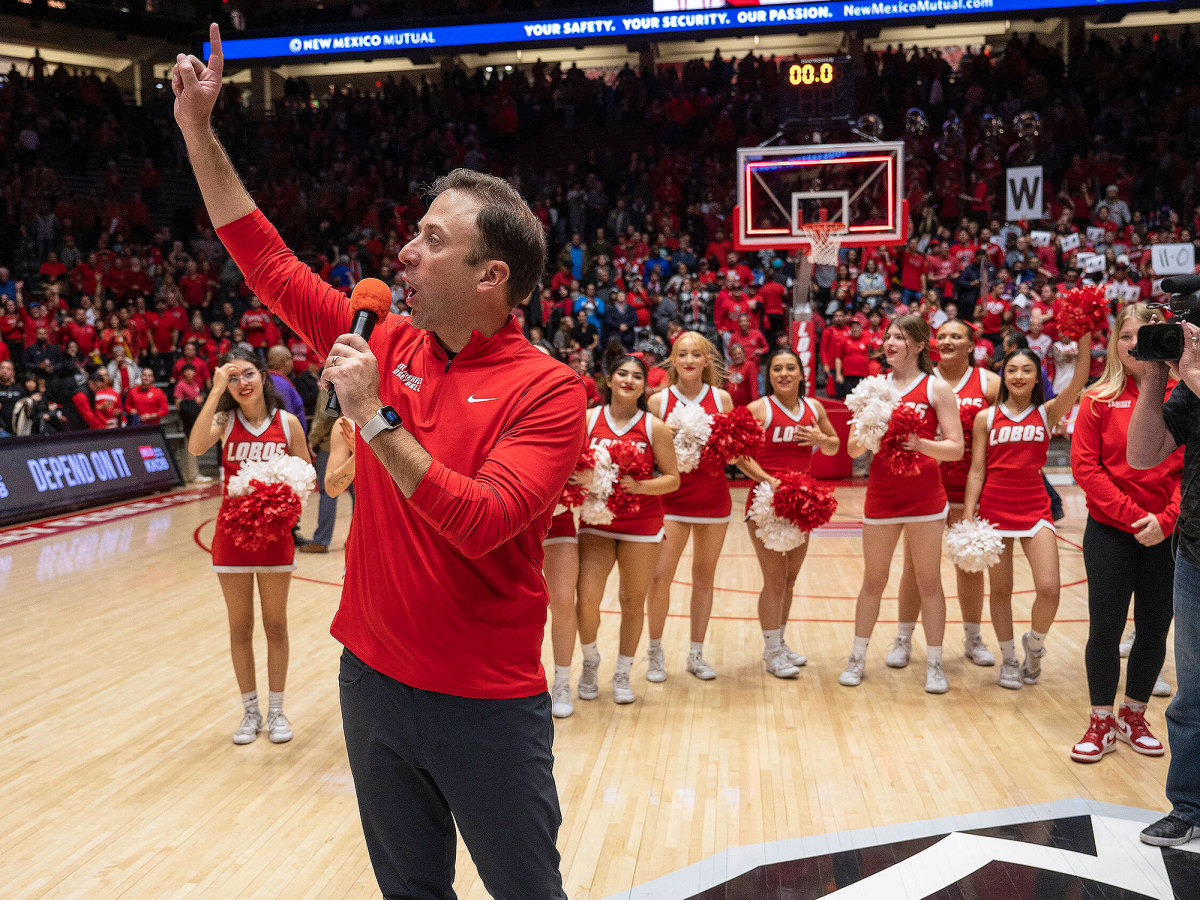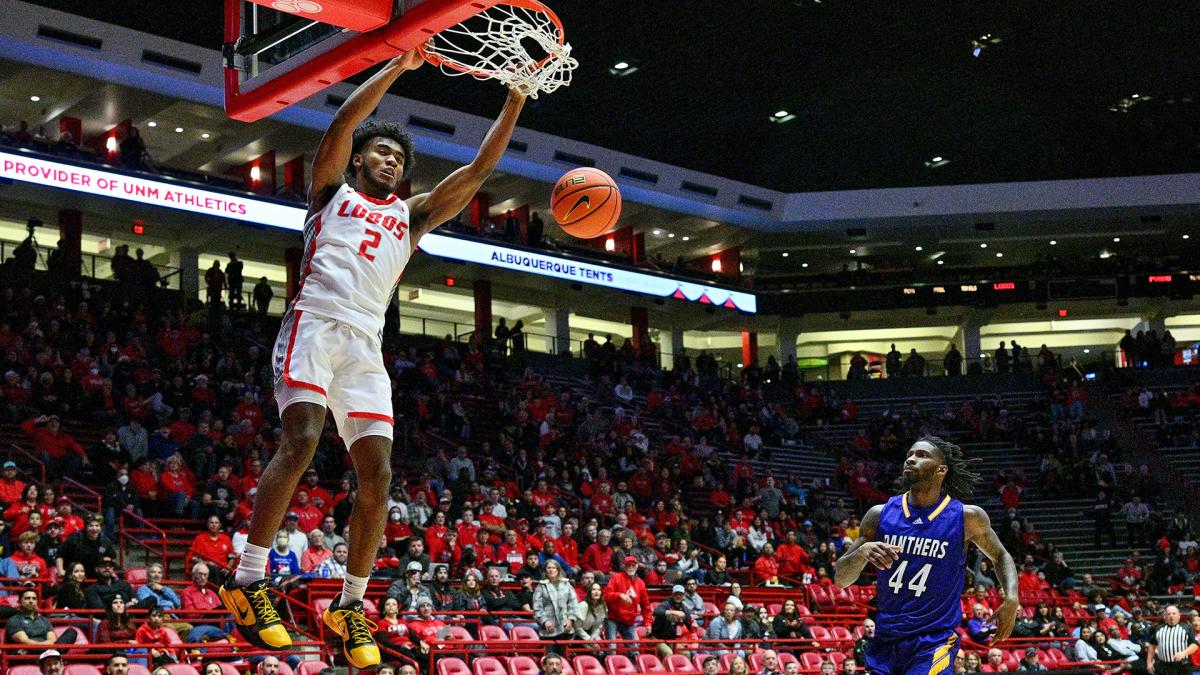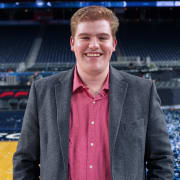New Mexico Basketball Is Back Home and Better Than Ever

The heart of the state of New Mexico sits a mile above sea level but 37 feet below the ground, in a bunker-like structure that comes to life for basketball games on winter nights.
The Pit is the center of the sports universe in New Mexico, a state without a major professional sports team that instead rallies like few others around its college basketball team, the Lobos. New Mexico is one of few places (think Kentucky, Indiana, Kansas) where college basketball is closer to a year-round obsession than a seasonal attraction. And The Pit has its place in the sport’s history, hosting the 1983 Final Four that featured the iconic championship-winning, buzzer-beating Lorenzo Charles dunk by for NC State that remains prominently featured in March Madness lore. It ranked 13th in Sports Illustrated’s favorite venues of the 20th century, in the same company as the likes of Augusta National and the Rose Bowl. As Richard Hoffer wrote then, “the noise created by fans, which has been measured at 125 decibels—the pain threshold for the human ear is 130—is a palpable force.”
In recent years, the heartbeat that emanates from The Pit has begun to fade. Eight straight years without a postseason berth after Steve Alford departed Albuquerque for UCLA tested fans’ patience, and no state was impacted more by COVID-19 restrictions on athletic competitions and large gatherings than New Mexico. But in 2022–23, the roar of one of college basketball’s best fan bases is back in full voice, and the 18–3 Lobos are in the AP Top 25 for the first time in nearly a decade, nationally relevant once more.
Two seasons ago, New Mexico basketball hit rock bottom. State restrictions due to COVID-19 forced the Lobos to spend their entire season playing as college basketball’s nomads. They spent much of the season playing home games in Lubbock, Texas, since New Mexico wouldn’t allow them to play games in The Pit, even with no fans present. Things weren’t trending upward under coach Paul Weir beforehand and only got worse once the team was forced to hit the road, as the Lobos won just four Division I games and dropped to No. 294 in KenPom, the program’s worst-ever finish by more than 100 spots. It was a shocking fall for a program that, for the most part, has been consistently relevant since The Pit opened in 1966. New Mexico and Weir mutually agreed to part ways that February, setting up perhaps the most important coaching search in the school’s history to try to right the ship.
“They had eight years of two coaches, Craig Neal and Paul Weir, of which seven of which were fans losing interest,” Geoff Grammer, the Lobos beat writer for the Albuquerque Journal and a New Mexico native, says. “The first 50 years The Pit was open, it was ranked in the top 25 in average home attendance. … The program is based on The Pit and based on the fans, and when they start losing interest it hurts the entire athletic department.”
New Mexico athletic director Eddie Nuñez had played and coached at Florida under Billy Donovan. A call from his former coach and boss connected him to Richard Pitino, who had worked under Donovan from 2009 to ’11 and regularly quips that he’s more like Donovan than his Hall of Fame father, Rick. Things were going south for Richard Pitino at Minnesota, making it a real possibility he would be available that spring. And Pitino checked all the boxes for Nuñez, particularly because of his experience coaching at a higher level.
“I didn't want a coach that hadn’t been at a high level because this is a tough place when it comes to handling the expectations,” Nuñez says. “This is a big program from the standpoint of what our fan base expects, what we expect, and I needed somebody who’s been there, who’s done it.”
Between working for his father at Louisville and for Donovan at Florida and spending eight years as a head coach in the Big Ten, Pitino was no stranger to expectations. Nuñez knew from the first phone call between the two that it was the right fit and wasted no time once Pitino was officially fired by Minnesota. Pitino was informed he was getting fired by Minnesota at 7 p.m. on a Sunday night, and by 7:15 Nuñez had offered him the New Mexico job. Pitino accepted and uprooted his life from the Land of 10,000 Lakes to the Land of Enchantment after less than a half-hour on the unemployment line, rather than taking a year off like many recently fired coaches do.
“A lot of people had said to me, ‘You should do TV; you’d be good on TV,’” Pitino says. “And I always thought to myself, Why is it that every TV guy tries to get head-coaching jobs?”

This was a rebuild that, on paper, looked like it would take time, with few impact returners and recruiting still impacted by COVID-19, as coaches not allowed to recruit off campus or host visitors that spring. But Pitino brought with him a building block in Jamal Mashburn Jr., who averaged more than 8 points per game as a freshman at Minnesota and elected to follow his coach down a level to the Mountain West.
“When I got fired, his dad [Jamal Mashburn Sr., who played for Rick Pitino at Kentucky] called me and said, ‘Just tell me where you're gonna end up because throughout the whole process you told us the truth,’” Pitino says. “It was a gratifying experience because right when you get fired, you don't feel real good. And to have one of your players say that felt good.”
Mashburn Jr. wasn’t the only son of an NBA player to sign on that first offseason. Jaelen House, the son of 11-year NBA veteran Eddie House, transferred from Arizona State to join the Lobos, forming a talented backcourt pairing with Mashburn Jr. that gave New Mexico life in Year 1. Mashburn brought a steadiness and maturity, while House brought the fire and a flair for the dramatic. The duo averaged more than 35 points per game and helped the Lobos climb from the 290s to a more respectable No. 161 national ranking, including an upset win over a Wyoming team that made the NCAA tournament. But the Lobos still lost 19 games, mostly due to a lack of an inside presence that caused the team’s defense to get torched.
Enter two more transfers: Wichita State’s Morris Udeze and UMKC’s Josiah Allick. Plug-and-play starters at center and power forward, respectively, Udeze and Allick have provided the interior punch to go with House and Mashburn in the backcourt. Udeze is one of the conference’s best low-post scorers, while Allick provides toughness on defense and on the glass. Suddenly, the Lobos had a roster capable of competing with the top of the Mountain West, just two seasons after finishing in last place in Weir’s final year. The result: a 14–0 start that made New Mexico the nation’s last unbeaten team, headlined by a road win at Saint Mary’s and beating Rick Pitino’s Iona team in Albuquerque. And with the Lobos winning and COVID-19 restrictions in the rearview mirror, it was time for The Pit to roar again.
It’s often hard to appreciate historic venues without being there. You can’t fully understand how steep the walls of seats are at Assembly Hall until you walk into the building. Any baseball fan who has been to Fenway Park remembers the feeling of walking out to field level on the first base side and being almost engulfed by the majesty of the Green Monster. The same goes for The Pit, which belongs on every fan’s bucket list.
Because the arena is literally built into the ground, you enter at concourse level, above all seating outside of a few luxury suites. The rows are numbered from top to bottom, so don’t be fooled into thinking you got a bargain by finding cheap “Row 1” tickets on StubHub. Most of the arena still is outfitted with old metal bleachers painted red. The ceiling is pitch black and flat with no jumbotron in the middle. There’s very little natural light coming in, even during the daytime, so everywhere but the court itself is quite dim. And there’s only one way onto the court from the bowels of the venue: an incredibly steep tunnel painted cherry red on three sides with The Pit’s slogan on one side: “Welcome to The Pit, a mile high and louder than …” The tunnel is so steep that it’s tradition for visiting teams to try to roll a ball up it, only to (usually) watch the ball die out and start rolling back as it approaches the top.
"I'm not just saying this ... that was the loudest building I have ever been in." - @LoboCoachPitino.
— Lobo Basketball (@UNMLoboMBB) January 21, 2023
Highlights from another memorable night in the legendary Pit. #GoLobos pic.twitter.com/1G01aOvA0Z
Jan. 20’s game against Boise State, which had an announced attendance of more than 14,500, had the type of energy you imagine a Friday-night high school football game in Texas feels like. There’s a community feel: Nuñez delivered beers to fans in the front row, and fans high-fived with the rest of their section after big plays. Everyone seemed to know one another and everyone seemed to care about the Lobos.
“This is a poor state and a very proud state where families have been for generations and generations,” Grammer says. “In terms of the go-to sport, when it’s at its best, it’s Lobo basketball and there’s not really a close second.”
“Everyone we know, they don’t ask me for tickets because they [already] have season tickets,” Pitino adds. “That’s unique.”
The players are the state’s stars. Allick came out through the team’s attached practice facility to start warmups just after doors opened and was immediately greeted by fans looking for autographs and selfies. Players get recognized at restaurants and around town. Some kids grow up idolizing not their favorite Yankee or Cowboy, but their favorite Lobo.
Watch college basketball with fuboTV. Start your free trial today.
“There are always a bunch of kids that I see that have so much energy for the game,” Mashburn says. “A lot of autographs, a lot of pictures, a lot of poster signings, all of that.”
When the game starts, the passion is palpable. The energy in the building grows and grows as momentum builds, then explodes after a big basket or blocked shot. And the sound seems to get trapped inside because of the venue’s unique layout, echoing and building upon itself on every big play. The fans know the names of the referees and hold nothing back when calling them out, and even the in-game host at one point told the fans to “go back to yelling at the refs” after a bad sequence for the Lobos.
Friday’s game didn’t quite sell out, but you’d never have known it from being there. The Pit erupted time after time as momentum swung back and forth, before eventually exploding on a game-winning layup in the final seconds of overtime by Udeze. Pitino, who has coached everywhere from Cameron Indoor Stadium to Mackey Arena, called it “the loudest building I have ever been in, by far. Not even close.”
“I couldn’t hear myself,” Pitino said postgame. “That was as good an environment and as loud a crowd as I have ever seen.”

After last week’s home win against San Jose State, Pitino was about to walk up the tunnel to the locker room when a fan ran down from the stands with a gift: a box of Franzia red wine.
“I'm like, ‘Well how did you get this in the building?’” Pitino says with a laugh. “And then I have to walk up the ramp with wine!”
Pitino’s father, Rick, is well known for his love of wine, though Franzia (a box can be found at grocery stores for under $15) seems unlikely to pique his interest. It may not be Richard’s taste either, but the box sits in the corner of his office on display and will for a while.
“That reminds me of how awesome this place is,” Pitino says.
Another reminder came the week before, when the team was returning to Albuquerque after a road win over Mountain West favorite San Diego State the day before. The Lobos were greeted in the airport by a contingent of New Mexico fans there to show their support, all decked out in Lobos gear.
“I’m walking, not really looking up, and all the sudden I see about 15 people and they’ve got pom-poms,” Pitino says. “I asked [one of them] ‘You came to meet us off the plane for a regular-season game?’ and she goes ‘Yeah, keep winning and it will get bigger and bigger.’
“It’s a throwback place. They just love it so much. I have been in a lot of places and I truly believe that this is one of the best fanbases in college basketball.”
